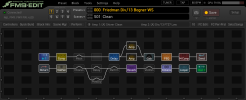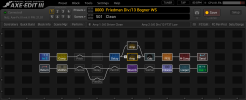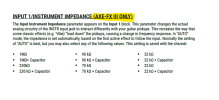NattyBar
Inspired
I'm about a year and a half into my Fractal journey (bought the AxeFX III in May 2021) and I'm still loving how great Fractal gear is! The amp modelling, the effects, the simplicity and complexity... It's all fantastic and so is the community of people willing to help others navigate the learning curves.
Even though I have loved the AxeFX for the past 18 months - I was one of the people who were hoping for a larger floorboard unit because living in a major international city often means that public transport is the most convenient option and carrying a rack unit and separate controller does start to get annoying. So when the FM9 was announced it looked perfect even though I was unsure if I could make the lower DSP work for larger presets (which would get around 75-80% on the AxeFX).
As expected, loading my main AxeFX presets on the FM9T maxed out the CPU so I had to take a different approach and build core tones on the FM9T using different settings and blocks. This was definitely possible (with subtle differences mostly from plex/pitch/reverb blocks) but I figured I'd play the FM9 for 2-3 months and then decide if the lower DSP and block trade-offs were worth the smaller form factor and convenience.
Well 3 months later I can say that the answer is 100% - the FM9 (Turbo) is absolutely perfect for live use and I don't have any issue with the lower DSP. Two weeks ago I listed the AxeFX for sale and just before the buyer turned up today I decided to do a quick experiment and load my main preset from the FM9T back into the AxeFX. I was a little surprised by the CPU usage between the two units...
FM9T:

AxeFX III MK II:

These screenshots show that how a preset is built makes a big difference on CPU usage for both units!! Since the amp, delay, and reverb blocks receive dedicated DSP on the FM9 it means that this preset uses almost the same CPU on both the FM9T and the AxeFX. So while the AxeFX is more powerful and flexible with its DSP, I/O, and all the other benefits - the FM9T is still a powerful unit and there are a number of ways to achieve similar outcomes on both units which is pretty spectacular.
Disclaimer: I didn't go through and optimise or correct any settings on the AxeFX before the buyer turned up so I'm assuming there are probably some CPU savings in there to be found.
The big takeaways from my experience:
1) Both units are amazing pieces of kit and how you approach their use is an important consideration - an overly simplistic comparison of total DSP is a pretty poor proxy. Cliff and the team are world-class in developing these products and squeezing the most out of the available resources.
2) For those who are unsure about whether the FM9T is powerful enough compared to the AxeFX the above shows there is plenty of resources available to create some intricate rigs. You may need to approach the process of creating tones differently but there are multiple paths you can take.
3) The more convenient form factor and weight of the FM9T is a big win and after some experimentation the trade-off in DSP hasn't been an issue for me.
Kudos to the Fractal team!
Even though I have loved the AxeFX for the past 18 months - I was one of the people who were hoping for a larger floorboard unit because living in a major international city often means that public transport is the most convenient option and carrying a rack unit and separate controller does start to get annoying. So when the FM9 was announced it looked perfect even though I was unsure if I could make the lower DSP work for larger presets (which would get around 75-80% on the AxeFX).
As expected, loading my main AxeFX presets on the FM9T maxed out the CPU so I had to take a different approach and build core tones on the FM9T using different settings and blocks. This was definitely possible (with subtle differences mostly from plex/pitch/reverb blocks) but I figured I'd play the FM9 for 2-3 months and then decide if the lower DSP and block trade-offs were worth the smaller form factor and convenience.
Well 3 months later I can say that the answer is 100% - the FM9 (Turbo) is absolutely perfect for live use and I don't have any issue with the lower DSP. Two weeks ago I listed the AxeFX for sale and just before the buyer turned up today I decided to do a quick experiment and load my main preset from the FM9T back into the AxeFX. I was a little surprised by the CPU usage between the two units...
FM9T:

AxeFX III MK II:

These screenshots show that how a preset is built makes a big difference on CPU usage for both units!! Since the amp, delay, and reverb blocks receive dedicated DSP on the FM9 it means that this preset uses almost the same CPU on both the FM9T and the AxeFX. So while the AxeFX is more powerful and flexible with its DSP, I/O, and all the other benefits - the FM9T is still a powerful unit and there are a number of ways to achieve similar outcomes on both units which is pretty spectacular.
Disclaimer: I didn't go through and optimise or correct any settings on the AxeFX before the buyer turned up so I'm assuming there are probably some CPU savings in there to be found.
The big takeaways from my experience:
1) Both units are amazing pieces of kit and how you approach their use is an important consideration - an overly simplistic comparison of total DSP is a pretty poor proxy. Cliff and the team are world-class in developing these products and squeezing the most out of the available resources.
2) For those who are unsure about whether the FM9T is powerful enough compared to the AxeFX the above shows there is plenty of resources available to create some intricate rigs. You may need to approach the process of creating tones differently but there are multiple paths you can take.
3) The more convenient form factor and weight of the FM9T is a big win and after some experimentation the trade-off in DSP hasn't been an issue for me.
Kudos to the Fractal team!


